THE CIRCUITS in this manual have been designed for maximum versatility; many of them have a range of applications limited only by the imagination and ingenuity of the circuit builder. The following descriptions, then, are to be used only as a guide by those who wish to know what circuit best applies to a certain hobby area. For maximum value from the manual, all circuits should be examined and some thought given to how each could be applied to the area of interest.
MOTORIST
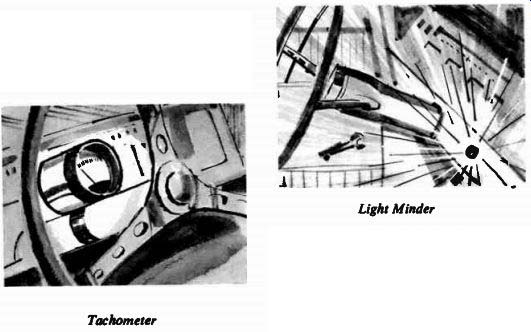
----- Tachometer
There are four circuits in the Hobby Circuits Manual that can be used to advantage by the motorist: the temperature alarm, the tachometer, the battery charger, and the light minder.
The temperature alarm is very sensitive; when its sensor is mounted out side the car, the alarm signals the driver when road icing conditions exist so that he can adjust his speed accordingly.
The tachometer adds to car engine life by providing an indication of engine speed, an indication that allows the driver to shift a car with a manual transmission at the optimum engine speed or to monitor the shifting of a car with an automatic transmission to Light Minder determine whether it is shifting properly. Besides saving wear on the engine, proper shifting saves gas.
The light minder is a particularly good device to have on those days when fog or rain requires that head-lights be used in the daylight hours.
Anyone who has returned to his car after several hours to find the battery dead as a result of his having left the lights on will appreciate the function performed by this device.
The battery-charger circuit contained in the Hobby Circuits Manual has a charging rate of 1 ampere and is designed for use with low-ampere-hour batteries such as those used in motor cycles and photoflash units. The charger may also be used to charge automobile batteries but the charging time is longer. If the charger is used at regular intervals, however, it will prove more than sufficient to keep an auto battery up to full charge.
RADIO AMATEUR
There are 13 circuits in the Manual that can be used to advantage by the radio amateur. They are as follows: Microphone Preamplifier Simple Code-Practice Oscillator Audio Oscillator Semiautomatic Electronic Keyer Automatic Keyer Frequency-Selective AF Amplifier Audio Amplifier Audio Mixer, Compressor, and Line Amplifier Dip/Wave Meter Variable-Frequency Oscillator VFO Calibrator Audio-Frequency-Operated Switch Power Supplies The microphone preamplifier is designed to boost the output of most dynamic microphones to a normal level of 0.5 volt to 1 volt. The preamplifier is compatible with the mixer, compressor, and line amplifier circuit and the audio power amplifier circuit described in this Manual.
The integrated-circuit code-practice oscillator is a simple but useful circuit that can be used in a code class.
The audio oscillator circuit produces a sine-wave output. This oscillator can be used for code practice, for keying a transmitter through the built in relay, or for adjusting a linear amplifier.
The semiautomatic key generates a dot or a series of dots depending on how long the paddle-key is held in the dot position; dashes must be made manually. The fully automatic electronic keyer, on the other hand, generates both dots and dashes automatically. The dot repetition rate of both keyers and the dash repetition rate of the fully automatic keyer can be varied by means of a speed potentiometer.
Both of these keys make quality code transmission easier.
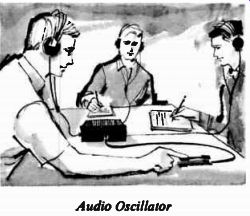
Audio Oscillator
The frequency-selective audio-frequency amplifier is designed to amplify signals at only one predetermined frequency; at this frequency the voltage gain is about 20 to 30. At other frequencies the gain is approximately unity. This circuit is very useful under conditions of heavy interference because it has the ability to eliminate the side noise and let the desired signal through.
The audio amplifier is a general purpose unit that can be used around the ham shack in any application that requires an amplifier with a power output up to 7.5 watts. The amplifier is compatible with all of the circuits in the Manual that require output amplification.
When installed in the microphone circuit, the audio mixer, compressor, and line amplifier allows the transmitter to be modulated at its maximum capability. Maximum transmitter modulation ensures maximum trans mission of intelligence.
The dip/wave meter is an extremely useful tool for the radio amateur or experimenter in electronics because it allows him to measure the resonant frequency and consequently the inductance and capacitance of both energized and unenergized radio-frequency circuits. The meter is battery-operated and hand-held.
Control of frequencies from 3.5 MHz through vhf on the amateur bands is possible with the variable frequency oscillator circuit. The MOS field-effect transistor used in the circuit requires an operating potential of only 10 volts; this voltage can be obtained from an automobile or dry battery through a regulator, or from one of the low-voltage power supplies described in this Manual. Because the MOS transistor generates so little heat, the entire vf o can be enclosed in a box with its tuning coils and capacitors.

Audio Mixer, Compressor, and Line Amplifier
The vfo calibrator can be used by a ham operator to calibrate points on a vfo dial that lie outside the tuning range of an amateur-band receiver. A 100-kHz output provided by the calibrator can be used to calibrate receivers and test equipment, such as grid-dip meters.
The most common use of the audio frequency-operated switch for the radio amateur is to control a radio transmitter. The af switch eliminates the need for manual action and is designed with a slight delay action on turn-off so that pauses in speech will not cause the transmitter to turn off.
Four power supplies are shown; the voltages of two are predetermined and fixed; the voltages of the other two are continuously variable within the rated values of the supplies. The output voltage of the fixed supplies is determined by fixed circuit components. The universal series power supply is designed to provide output voltages from 6 volts to 35 volts; the universal shunt supply provides 6 volts or less.
The two continuously variable supplies are designed to deliver voltages in the ranges of 4.5 to 12 volts and zero to 12 volts, respectively. The 4.5-to-12-volt design is the simpler, more economical of the two. The maximum output cur rent for any of these supplies is 1 ampere.
PHOTOGRAPHER
Of particular interest to the photographer are the universal timer, the enlarger exposure meter, the temperature alarm, the metronome, and the battery-charger circuits.
The universal timer circuit is a very stable, resettable circuit that can be adjusted over a wide range of times. It can be used for precise timing of enlarger exposures, print-development sequences, and other darkroom procedures.

--------- Enlarger Exposure Meter
The enlarger exposure meter makes use of a photocell circuit to permit extremely accurate timing of enlargements. The meter used greatly simplifies the work required to set up the enlarger and to obtain consistently good reproductions.
The temperature alarm can be used to check the temperature of any solution in the darkroom (that is, whether it is warm or cool enough to perform its function satisfactorily). When used in a running-water bath, the tempera ture alarm will signal a harmful change of temperature instantaneously.
The metronome circuit is a very useful tool in the darkroom because it permits time to be measured audibly.
If the "beep" rate of the timer is set at 1 second, the passage of an amount of time can be noted simply by counting the "beeps." The battery-charger circuit was originally designed for the prime purpose of providing photographers with a means of recharging the batteries of their portable strobe units. The savings in battery cost realized when the charger is used are substantial.
Although this charger can be used to charge auto batteries, its special slow charging rate makes it more applicable to the charging of smaller batteries.
MUSIC LOVER
Seven circuits are described that will add to the enjoyment of music lovers whose delight is in listening, as well as those who prefer to make their own music.
The audio mixer, compressor, and line amplifier circuit permits the audio enthusiast to obtain the uniform audio levels required in the production of very-high-quality tape recordings.
The general-purpose high-fidelity audio power amplifier, when coupled with the phonograph preamplifier circuit, provides a high quality audio system.
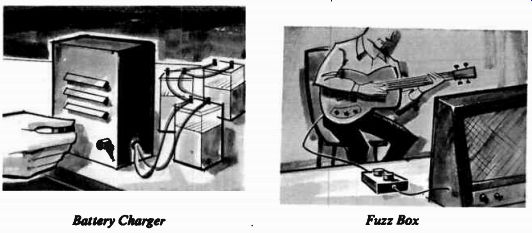
-------- Battery Charger; Fuzz Box
The phonograph preamplifier is designed for use with a magnetic pickup capable of supplying an input signal of at least 5 millivolts and has provisions for tape and tuner input. At the 5-millivolt signal level, the preamplifier delivers an output of at least 1 volt.
The microphone preamplifier was designed to boost the output of a dynamic microphone to a normal level of 0.5 volt to 1 volt. The preamplifier is compatible with the audio amplifier circuit and the mixer, compressor, and line amplifier circuit described in this Manual.
The fuzz box is intended to be used with a guitar; however, it may be used with any instrument whose musical output is electrically amplified. It can be used with the audio power amplifier circuit described in the Manual. The Organ fuzz box changes the character of the sound produced by an instrument and makes possible the generation of a variety of sounds of which the instrument alone is not capable.
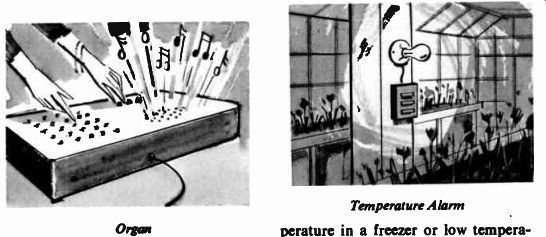
------------ Organ ------ Temperature Alarm
The single-voice organ operates through five octaves and has variable tone character, volume, and tremolo depth controls. A full, rich note is produced that can be amplified by the audio-amplifier circuit to produce a true organ sound.
The electronic metronome replaces the click of the mechanical metronome with a "beep" and makes available a continuous, wide range of time intervals. The electronic metronome has an advantage over the mechanical type in that it does not have to be re-wound.
HOME OWNER
Eight circuits in the Hobby Circuits Manual have been designed with the home owner in mind. These circuits, some for use indoors, some for use outdoors, some battery-operated, and some requiring house power, will make the home owner's life more pleasant by saving steps or unnecessary labor or by adding to the appearance of his home; some circuits also increase the safety of the home.
The temperature alarm, for example, can be used to warn of high temperature in a freezer or low temperature out-of-doors. It can also be used as a fire alarm or to warn of abnormally high temperatures in a furnace room. Because the alarm is provided with a standby battery, it is not dependent upon utility-company power and will continue to operate during a power failure.
---------
The lamp dimmer can be used in the dining, living, or play room to attain the exact lighting level desired. The simplicity of the lamp dimmer makes it extremely easy to build.
The light-operated switch is a particularly versatile circuit that allows lights to be automatically and remotely turned on and off. If the house is left unattended for some time, the switch will ensure that house and yard lights are on during the night. The switch can also be set to turn on when headlights are shined on the triggering mechanism; in a similar application dock lights may be turned on by a boat owner as he returns to port for the night. In both of these applications the light sensor is mounted at the end of a long tube so that the switching circuit is activated only when the light shines down the tube.
The moisture-controlled switch was originally designed to be used in con junction with the temperature alarm so that rain-gutter defrosters would be turned on only when ice was present in the gutters. Without the moisture detector the defrosters would be activated every time the temperature fell below freezing whether ice was present or not.
Metal Detector
The metal detector is a handy device for locating underground pipes and for retrieving metal articles lost in sand, grass, or loose earth. The metal detector can also be used for "treasure" hunting by the amateur archaeologist and vacation beachcomber.
The motor speed control is most useful around the shop, where it can be used to adjust and regulate (maintain constant speed under condition of changing load) the speed of drills, buffers, and jigsaws. A power drill operated through the motor speed control can be made to rotate very slowly so that the drill can be used as a power screwdriver. Floor polishers, hair dryers, and commercial food mixers can also be controlled by this circuit.
The primary use of the electronic flasher is for switching decorative lights or signs on and off to add to their attractiveness. An address sign illuminated by a flashing light is a great help to visitors looking for that address for the first time.
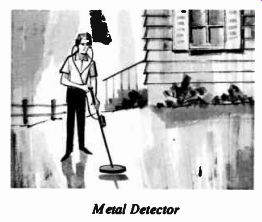
-----------
The electronic time delay is useful for activating an auditory device to signal the end of a time interval (e.g., to limit card and chess players to one minute of "thinking time"), or for making another device "wait" for a short time until some action can be taken.
NOVELTY AND MISCELLANEOUS CIRCUITS
The novelty and miscellaneous circuits include games, a hobby model vehicle control, a siren, power supplies, and the shift register, a circuit that is an integral part of several circuits in the Manual.
The game circuits are the electronic slot machine and the electronic die.
The slot-machine game duplicates the operation of the well-known Las Vegas Electronic Slot Machine model except that a push-button replaces the lever and three vertical columns of lights replace the spinning wheels. Instead of paying off in coin, the electronic slot machine indicates a score through one of six scoring lamps on its face.
Electronic Dice
The electronic die displays, by means of lights, any of the dot patterns that exist on the faces of a conventional die. If a pair of dice is desired, the single die can be operated twice or a second die can be built.
The siren circuit is battery-operated and can be used in conjunction with a burglar alarm or as a warning or signaling device. The siren makes a sound similar to that of a police siren but is not as loud.
The model train and race-car speed control provides smooth and continuous control of the speed of model vehicles designed to operate at dc voltages up to 12 volts. Model speed can be adjusted over the complete range from zero to full speed.

------------
Four power supplies are shown; the voltages of two are predetermined and fixed; the voltages of the other two are continuously variable within the rated values of the supplies. The output voltage of the fixed supplies is determined by fixed circuit components. The universal series power supply is designed to provide output voltage from 6 volts to 35 volts; the universal shunt supply provides 6 volts or less.
The two continuously variable supplies are designed to deliver voltages in the ranges of 4.5 to 12 volts and zero to 12 volts, respectively; the 4.5-to- 12-volt design is the simpler, more economical of the two. The maximum output current for any of 'these supplies is 1 ampere.
++++++++++++